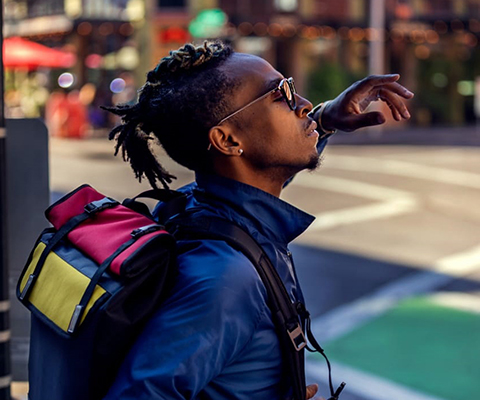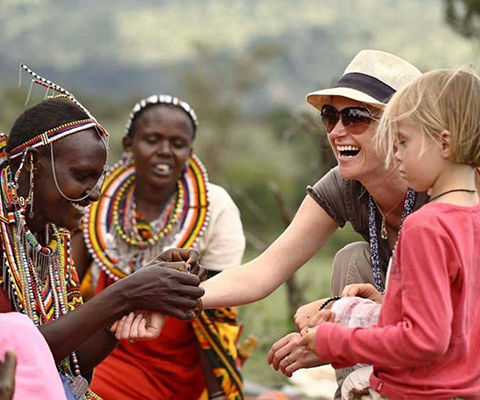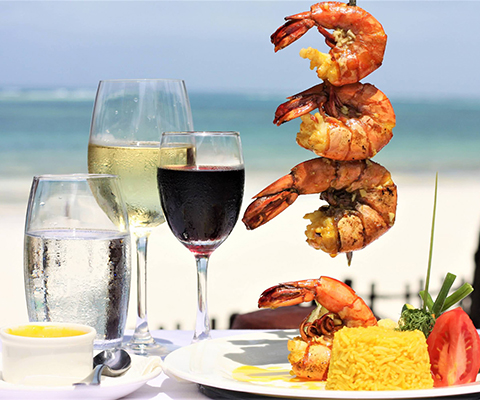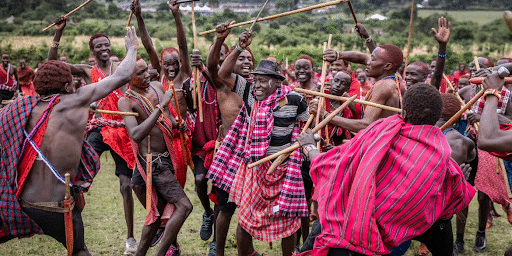By Cynthia Muthoni
Are you dreaming of more than just a typical safari in Kenya?
If you’re craving a deeper connection to the land, its people, and their stories, a traditional Maasai cultural tour might be exactly what you’re looking for. These immersive journeys go beyond wildlife viewing, offering a rare opportunity to step into the daily life, customs, and wisdom of one of East Africa’s most iconic tribes.
The Maasai, with their bold red shúkà wraps, rhythmic dances, and rich storytelling traditions, are not only a symbol of Kenya but a living culture that continues to thrive. On a guided visit to a Maasai village, you’ll witness ancient ceremonies, learn time-honored skills like beadwork and fire-making, and hear firsthand accounts from community members about what it means to be Maasai in today’s world.
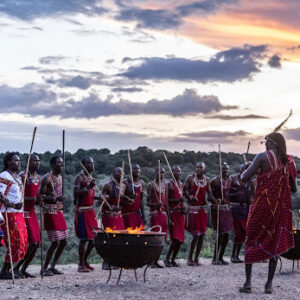
Maasai in traditional shúkà garments
Who Are the Maasai?
The Maasai are one of East Africa’s most renowned and visually distinctive communities. Indigenous to southern Kenya and northern Tanzania they are semi-nomadic people known for their vibrant clothing, strong warrior traditions, and deep spiritual connection to land and livestock .
Historically, the Maasai roamed the expansive plains of the Great Rift Valley, herding cattle and living in harmony with the natural world. Cattle remain central to Maasai life as a source of food and a symbol of wealth, status, and spiritual value. These traditional practices are still alive and well in the heart of the Maasai Mara, where visitors can experience authentic Maasai culture in Kenya through guided cultural tours.
Despite the pressures of modern life, many Maasai communities have preserved their language (Maa), rituals, dress, and oral storytelling traditions. From their iconic red shúkàs (cloth wraps) and intricate beadwork to the famous jumping dance (adumu) performed by warriors, Maasai culture remains visually striking and deeply meaningful. Traditional Maasai cultural tours offer an immersive experience for those seeking to understand these customs firsthand.
Today, the Maasai continue to balance tradition and change. While some community members pursue education and modern careers, others remain deeply rooted in age-old ways, offering visitors a rare and authentic glimpse into a living heritage that has endured for centuries.
Maasai Village Tours: Beyond the Safari
Maasai village tours are often integrated into broader cultural safaris itineraries, providing a unique blend of thrilling wildlife encounters and meaningful human connections. These immersive, guided experiences offer travelers the chance to:
- Walk through manyattas (traditional homesteads): Visitors are invited to explore the manyatta, the Maasai’s traditional home, and witness how the community lives, works, and thrives in harmony with nature.
- Engage in storytelling with elders: Elderly Maasai members share ancient stories, wisdom, and historical tales that offer a deep insight into the cultural fabric of the community.
Witness and sometimes participate in ceremonial dances: Travelers may have the rare opportunity to observe and, in some cases, join in the traditional Maasai dances, including the famous jumping dance (adumu), an expression of strength and community spirit.
- Learn traditional beadwork, fire-making, and food preparation: Hands-on activities allow visitors to appreciate the intricate skills involved in Maasai crafts, cooking, and fire-starting techniques passed down through generations.
What Are the Traditional Ceremonies of the Maasai?
The Maasai hold deeply spiritual and communal ceremonies that mark major life transition rites that are sacred and social. These traditional rituals are central to Maasai identity and help preserve cultural values across generations.
The Maasai mark important life transitions with deeply spiritual and communal ceremonies. Key rituals include:
- Enkipaata – Prepares young boys for manhood before circumcision.
- Emuratta – The circumcision ritual, a brave rite of passage into warriorhood.
- Eunoto – The ceremony that transitions warriors (morans) into elders, often celebrated with grand feasts and dances.
- Marriage Ceremonies – Involving colorful attire, elder blessings, and detailed beadwork symbolizing the union.
- Eokoto e-kule – A milk-sharing ritual that symbolizes peace and reconciliation between communities.
Observing these ceremonies, when permitted, provides unique insight into the spiritual and social fabric of the Maasai tribe.
Cultural Practices of the Maasai Tribe
The Maasai are admired not just for their striking appearance but for the way they have held onto their traditions in a changing world. Their everyday life is shaped by deep values of community, nature, and respect for ancestors passed down from one generation to the next. Their traditions include:
- Livestock herding as both an economic activity and a cultural identity
- Wearing the red shúkà and elaborate beadwork to signify age and social status
- A diet based on milk, meat, and blood
- Oral storytelling as a way to preserve history and values
- A social structure based on age-sets, communal living, and polygamy
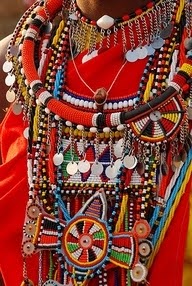
Maasai traditional beadwork
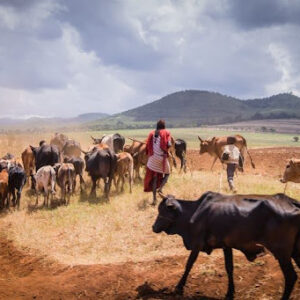
Maasai herding cattle
Can You Visit the Maasai Tribe?
Yes, Maasai communities welcome respectful visitors. Travelers engage directly with hosts through organized and locally guided Maasai village tours , they offer authentic narratives of their lives , values and changing roles in modern kenya .
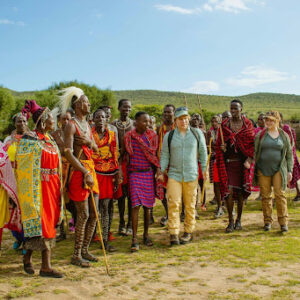
Tourists with Masaai
Respectful Travel Tips
Visiting Maasai communities is a privilege. Here’s how to make the most of the experience while honoring local customs and values:
- Always ask before taking photos, especially during ceremonies.
- Support locally owned or community-led tours.
- Dress modestly and follow cultural guidance from your guide.
- Approach experiences with curiosity and humility—listen and learn.
Step Into a Living Tradition
Participating in a traditional Maasai cultural tour is far more than a side trip it’s a transformative experience. It offers a lens into a world where tradition meets resilience, where every dance, story, and ceremony carries generations of meaning.
Frequently Asked Questions (FAQs)
Q: What are the traditional ceremonies of the Maasai?
A: Key ceremonies include Enkipaata (initiation), Emuratta (circumcision), Eunoto (transition to elder), marriages, and milk-sharing rituals like Eokoto e-kule.
Q: What are the cultural practices of the Maasai tribe?
A: They include cattle herding, red shukas and beadwork, traditional diets, communal living, and oral storytelling.
Q: Can you visit the Maasai tribe?
A: Yes, through organized and respectful village tours led by community members.
Q: What makes the Maasai Mara popular with tourists?
A: The Great Migration, Big Five game drives, scenic beauty, and cultural access to Maasai communities.
Q: Why is the Maasai Mara so expensive?
A: Due to conservation fees, luxury accommodations, and its premium status during the migration season.
Q: Which part of the Maasai Mara is best?
A: Mara Triangle for photography, private conservancies for exclusivity, and Sekenani/Talek for accessibility and wildlife diversity.

